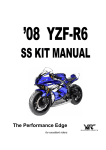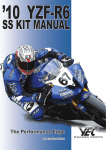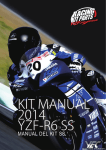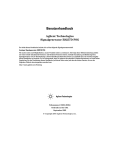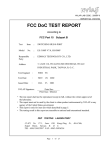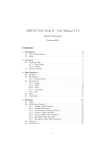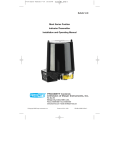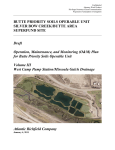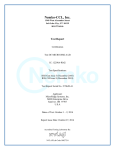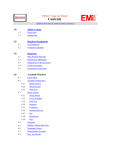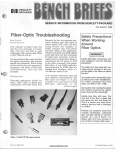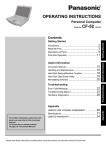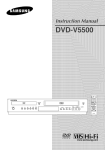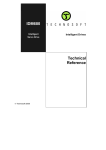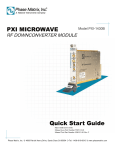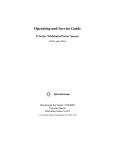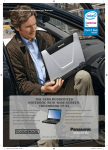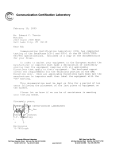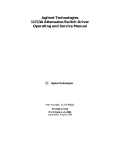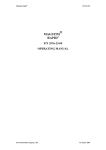Download FCC DoC Test Report
Transcript
PCTEST ENGINEERING LABORATORY, INC. 6660-B Dobbin Road, Columbia, MD 21045 USA Tel. 410.290.6652 / Fax 410.290.6554 http://www.pctestlab.com DECLARATION OF CONFORMITY (DoC) FCC Part 15B Manufacturer Name and Address: Clubbhouse Inventions LLC 6145 Stevens Forest Road Columbia, MD 21045 Date of Testing: July 13, 2009 Test Site/Location: PCTEST Lab, Columbia, MD, USA Test Report Serial No.: 0907101374 MANUFACTURER: Clubbhouse Inventions LLC MODEL: PB-4 EUT Type: USB Password Booster FCC Rule Part(s): FCC Part 15 Subpart B, Part 2.906 FCC Classification: FCC Class B Digital Device Test Procedure: ANSI C63.4-2003 The device bearing the FCC logo specified above is authorized under the DoC procedure and has been shown to comply with the applicable technical standards as indicated in the measurement report and has been tested in accordance with the measurement procedures specified in ANSI C63.4-2003 (See Test Report). These measurements were performed with no deviation from the standards. Test results reported herein relate only to the item(s) tested. This test report serves as the responsible party’s requirement to show that the above referenced equipment complies with the applicable technical standards for the DoC authorization procedure. I authorize and attest to the accuracy of data. All measurements reported herein were performed by me or were made under my supervision and are correct to the best of my knowledge and belief. I assume full responsibility for the completeness of these measurements and vouch for the qualifications of all persons taking them. NVLAP accreditation does not constitute any product endorsement by NVLAP or any agency of the United States Government. PCTEST certifies that no party to this application has been denied the FCC benefits pursuant to Section 5301 of the Anti-Drug Abuse Act of 1988, 21 U.S.C. 862. Model: PB-4 FCC Pt. 15B DECLARATION OF CONFORMITY TEST REPORT Test Report S/N: Test Dates: EUT Type: 0907101374 July 13, 2009 USB Password Booster © 2009 PCTEST Engineering Laboratory, Inc. Reviewed by: Quality Manager Page 1 of 22 REV 3.2DoC 02/06/09 T A B L E O F C O N T E N T S FCC Class B MEASUREMENT REPORT………………………...……………………………………………….3 1.0 2.0 3.0 4.0 INTRODUCTION ..............................................................................................................................4 1.1 EVALUATION PROCEDURE ................................................................................................................ 4 1.2 SCOPE .................................................................................................................................................. 4 1.3 PCTEST TEST LOCATION ................................................................................................................... 4 PRODUCT INFORMATION..............................................................................................................5 2.1 EQUIPMENT DESCRIPTION ................................................................................................................ 5 2.2 OPERATION MODE.............................................................................................................................. 5 2.3 EMI SUPPRESSION DEVICE(S)/MODIFICATIONS ............................................................................. 5 DESCRIPTION OF TEST.................................................................................................................6 3.1 CONDUCTED EMISSIONS................................................................................................................... 6 3.2 RADIATED EMISSIONS........................................................................................................................ 7 SAMPLE CALCULATIONS ..............................................................................................................8 4.1 CONDUCTED EMISSION MEASUREMENT SAMPLE CALCULATION ............................................... 8 4.2 RADIATED EMISSION MEASUREMENT SAMPLE CALCULATION.................................................... 8 5.0 TEST EQUIPMENT CALIBRATION DATA ......................................................................................9 6.0 ENVIRONMENTAL CONDITIONS .................................................................................................10 7.0 TEST DATA ....................................................................................................................................11 7.1 SUMMARY .......................................................................................................................................... 11 7.2 TEST SUPPORT EQUIPMENT ........................................................................................................... 11 7.3 RADIATED MEASUREMENT DATA ................................................................................................... 12 7.4 LINE CONDUCTED MEASUREMENT DATA ..................................................................................... 13 8.0 CONCLUSION................................................................................................................................15 9.0 TEST SETUP PHOTOGRAPHS ....................................................................................................16 10.0 EUT PHOTOGRAPHS ...................................................................................................................19 11.0 DUTIES OF THE RESPONSIBLE PARTY.....................................................................................20 Model: PB-4 FCC Pt. 15B DECLARATION OF CONFORMITY TEST REPORT Test Report S/N: Test Dates: EUT Type: 0907101374 July 13, 2009 USB Password Booster © 2009 PCTEST Engineering Laboratory, Inc. Reviewed by: Quality Manager Page 2 of 22 REV 3.2DoC 02/06/09 MEASUREMENT REPORT FCC Part 15B – Unintentional Radiators § 2.1033 General Information U.S. RESPONSIBLE PARTY: Clubbhouse Inventions LLC 6145 Stevens Forest Road ADDRESS: Columbia, MD 21045 TEST SITE: PCTEST ENGINEERING LABORATORY, INC. TEST SITE ADDRESS: 6660-B Dobbin Road, Columbia, MD 21045 USA FCC RULE PART(S): FCC Part 15 Subpart B, Part 2.906 MODEL: PB-4 Test Device Serial No.: N/A FCC CLASSIFICATION: FCC Class B Digital Device DATE(S) OF TEST: July 13, 2009 Production Pre-Production Engineering Test Methodology Both conducted and radiated measurements were taken using the methods and procedures described in ANSI C63.4-2003. Radiated testing was performed at an antenna-to-EUT distance of 3 meters. Test Facility / NVLAP Accreditation Conducted and radiated tests were performed at PCTEST Engineering Lab in Columbia, MD 21045, U.S.A. • PCTEST facility is an FCC registered (PCTEST Reg. No. 90864) test facility with the site description report on file and has met all the requirements specified in Section 2.948 of the FCC Rules and Industry Canada (IC 2451). • PCTEST Lab is accredited by U.S. National Institute of Standards and Technology (NIST) under the National Voluntary Laboratory Accreditation Program (NVLAP) in EMC, Telecommunication, and FCC for satisfactory compliance with criteria established in Title 15, Part 285 Code of Federal Regulations. (NVLAP Lab code: 100431-0). • PCTEST Lab is a recognized U.S. Conformity Assessment Body (CAB) in EMC and R&TTE (n.b. 0982) under the U.S.-EU Mutual Recognition Agreement (MRA). PCTEST TCB is a Telecommunication Certification Body (TCB) accredited to ISO/IEC Guide 65 by the American National Standards Institute (ANSI) in all scopes of FCC Rules and Industry Canada Standards (RSS). PCTEST facility is an IC registered (IC-2451) test laboratory with the site description on file at Industry Canada. • • Model: PB-4 FCC Pt. 15B DECLARATION OF CONFORMITY TEST REPORT Test Report S/N: Test Dates: EUT Type: 0907101374 July 13, 2009 USB Password Booster © 2009 PCTEST Engineering Laboratory, Inc. Reviewed by: Quality Manager Page 3 of 22 REV 3.2DoC 02/06/09 1.0 1.1 INTRODUCTION Evaluation Procedure The measurement procedure described in the American National Standard for Methods of Measurement of Radio-Noise Emission from Low-Voltage Electrical and Electronic Equipment in the Range of 9kHz to 40GHz (ANSI C63.4-2003) was used in the measurement of the Clubbhouse USB Password Booster Model: PB-4. Deviation from measurement procedure…………………………………………….....................................None 1.2 Scope Measurement and determination of electromagnetic emissions (EMC) of radio frequency devices including intentional and/or unintentional radiators for compliance with the technical rules and regulations of the Federal Communications Commission. 1.3 PCTEST Test Location The map at the right shows the location of the PCTEST LABORATORY, its proximity to the FCC Laboratory, the Columbia vicinity are, the Baltimore-Washington Internt’l (BWI) airport, the city of Baltimore and the Washington, DC area. (see Figure 1-1). These measurement tests were conducted at the PCTEST Engineering Laboratory, Inc. facility in New Concept Business Park, Guilford Industrial Park, Columbia, Maryland. The site address is 6660-B Dobbin Road, Columbia, MD 21045. The test site is one of the highest points in the Columbia area with an elevation of 390 feet above mean sea level. The site coordinates are 39o 11’15” N latitude and 76o 49’38” W longitude. The facility is 1.5 miles North of the FCC laboratory, and the ambient signal and ambient signal strength are approximately equal to those of the FCC laboratory. There are no FM or TV transmitters within 15 miles of the site. The detailed description of the measurement facility was found to be in compliance with the requirements of § 2.948 according to ANSI C63.42003 on January 27, 2006. Model: PB-4 Figure 1-1. Map of the Greater Baltimore and Metropolitan Washington, D.C. area FCC Pt. 15B DECLARATION OF CONFORMITY TEST REPORT Test Report S/N: Test Dates: EUT Type: 0907101374 July 13, 2009 USB Password Booster © 2009 PCTEST Engineering Laboratory, Inc. Reviewed by: Quality Manager Page 4 of 22 REV 3.2DoC 02/06/09 2.0 2.1 PRODUCT INFORMATION Equipment Description The Equipment Under Test (EUT) is the Clubbhouse USB Password Booster Model: PB-4. The test data contained in this report pertains only to the emissions due to the digital circuitry of the EUT. Manufacturer / Model Description Clubbhouse / Model: PB-4 USB Password Booster Table 2-1. EUT Equipment Description 2.2 Operation Mode The Clubbhouse USB Password Booster Model: PB-4 was tested with a NOTEBOOK connected via USB interface port. Please see Section 7.0 and the test setup photographs for more information on the test setup. 2.3 EMI Suppression Device(s)/Modifications No EMI suppression device(s) were added and modifications were made during testing. Model: PB-4 FCC Pt. 15B DECLARATION OF CONFORMITY TEST REPORT Test Report S/N: Test Dates: EUT Type: 0907101374 July 13, 2009 USB Password Booster © 2009 PCTEST Engineering Laboratory, Inc. Reviewed by: Quality Manager Page 5 of 22 REV 3.2DoC 02/06/09 3.0 3.1 DESCRIPTION OF TEST Conducted Emissions Figure 3-1. Shielded Enclosure Line-Conducted Test Facility Figure 3-2. Line Conducted Emission Test Set-Up Figure 3-3. Wooden Table & Bonded LISNs The line-conducted facility is located inside a 16’x20’x10’ shielded enclosure, manufactured by Ray Proof Series 81 (see Figure 3-1). The shielding effectiveness of the shielded room is in accordance with MIL-Std-285 or NSA 65-5. A 1m x 1.5m wooden table 80cm high is placed 40cm away from the vertical wall and 1.5m away from the sidewall of the shielded room (see Figure 3-2). Solar Electronics and EMCO Model 3725/2 (10kHz-30MHz) 50Ω/50μH Line-Impedance Stabilization Networks (LISNs) are bonded to the shielded room (see Figure 3-3). The EUT is powered from the Solar LISN and the support equipment is powered from the EMCO LISN. Power to the LISNs are filtered by a high-current high-insertion loss Ray Proof power line filter (100dB 14Hz-10GHz). The purpose of the filter is to attenuate ambient signal interference and this filter is also bonded to the shielded enclosure. All electrical cables are shielded by braided tinned copper zipper tubing with an inner diameter of ½”. If the EUT is a DC-powered device, power will be derived from the source power supply it normally will be powered from and this supply line(s) will be connected to the Solar LISN. The LISN schematic diagram is shown (see Figure 3-4). All interconnecting cables more than 1 meter were shortened to a 1 meter length by non-inductive bundling (serpentine fashion). Sufficient time for the EUT, support equipment, and test equipment was allowed in order for them to warm up to their normal operating condition. The RF output of the LISN was connected to the spectrum analyzer to determine the frequency producing the maximum EME from the EUT. The spectrum was scanned from 150kHz to 30MHz with a spectrum analyzer. The detector function was set to CISPR quasi-peak and average mode. The bandwidth of the analyzer was set to 10kHz. The EUT, support equipment, and interconnecting cables were arranged and manipulated to maximize each EME emission. Each emission was maximized by: switching power lines; varying the mode of operation or resolution; clock or data exchange speed; scrolling H pattern to the EUT and/or support equipment, and powering the monitor from the floor mounted outlet box and the computer aux AC outlet, if applicable; whichever determined the worst-case emission. Photographs of the worst-case emission can be seen in the test setup photographs. Each EME reported was calibrated using the Agilent E8257D (250kHz – 20GHz) PSG Signal Generator. Figure 3-4. LISN Schematic Diagram Model: PB-4 FCC Pt. 15B DECLARATION OF CONFORMITY TEST REPORT Test Report S/N: Test Dates: EUT Type: 0907101374 July 13, 2009 USB Password Booster © 2009 PCTEST Engineering Laboratory, Inc. Reviewed by: Quality Manager Page 6 of 22 REV 3.2DoC 02/06/09 3.2 Radiated Emissions Figure 3-5. 3-Meter Test Site Figure 3-6. Dimensions of Outdoor Test Site Figure 3-7. Turntable and System Setup Preliminary measurements were made indoors at 1-meter using broadband antennas, broadband amplifiers, and spectrum analyzers to determine the frequency producing the maximum EME. Appropriate precaution was taken to ensure that all EME from the EUT were maximized and investigated. The system configuration, clock speed, mode of operation or video resolution, and turntable azimuth with respect to the antenna was noted for each frequency found. The spectrum was scanned from 30 to 200 MHz using a bi-conical antenna and from 200 to 1000 MHz using a log-spiral antenna. Above 1 GHz, linearly polarized double ridge horn antennas were used. Final measurements were made outdoors at 3-meter test range using RobertsTM Dipole antennas or horn antennas (see Figure 3-5). The test equipment was placed on a wooden and plastic bench situated on a 1.5m x 2m area adjacent to the measurement area (see Figure 3-6). Sufficient time for the EUT, support equipment, and test equipment was allowed in order for them to warm up to their normal operating condition. The detector function was set to CISPR quasi-peak mode and the bandwidth of the spectrum analyzer was set to 100kHz for frequencies below 1GHz or 1MHz for frequencies above 1GHz. Above 1GHz the detector function was set to average mode (RBW = 1MHz, VBW = 10Hz). The half-wave dipole antenna was tuned to the frequency found during preliminary radiated measurements. The EUT, support equipment and interconnecting cables were re-configured to the set-up producing the maximum emission for the frequency and were placed on top of a 0.8-meter high non-metallic 1 x 1.5 meter table (see Figure 3-7). The EUT, support equipment, and interconnecting cables were re-arranged and manipulated to maximize each EME emission. The turntable containing the system was rotated and the height of the receive antenna was varied 1 to 4 meters and stopped at the azimuth and height producing the maximum emission. Each emission was maximized by: varying the mode of operation or resolution; clock or data exchange speed; scrolling H pattern to the EUT and/or support equipment, and powering the monitor from the floor mounted outlet box and the computer aux AC outlet, if applicable; and changing the polarity of the antenna, whichever determined the worst-case emission. Photographs of the worst-case emission can be seen in the test setup photographs. Each EME reported was calibrated using the Agilent E8257D (250kHz – 20GHz) PSG Signal Generator. The Theoretical Normalized Site Attenuation Curves for both horizontal and vertical polarization are shown in Figure 3-8. Figure 3-8. Normalized Site Attenuation Curves (H&V) Model: PB-4 FCC Pt. 15B DECLARATION OF CONFORMITY TEST REPORT Test Report S/N: Test Dates: EUT Type: 0907101374 July 13, 2009 USB Password Booster © 2009 PCTEST Engineering Laboratory, Inc. Reviewed by: Quality Manager Page 7 of 22 REV 3.2DoC 02/06/09 4.0 4.1 SAMPLE CALCULATIONS Conducted Emission Measurement Sample Calculation @ 20.3 MHz Class B limit = 60.0 dBμV (Quasi-peak limit) Reading = - 57.8 dBm (calibrated quasi-peak level) Convert to dbμV = - 57.8 + 107 = 49.2 dBμV Margin = 49.2 - 60.0 = - 10.8 dB = 10.8 dB below limit 4.2 Radiated Emission Measurement Sample Calculation @ 66.7 MHz Class B limit = 100 μV/m = 40.0 dBμV/m Reading = - 76.0 dBm (calibrated level) Convert to dbμV = - 76.0 + 107 = 31.0 dBμV Antenna Factor + Cable Loss = 5.8 dB/m Total Margin = 36.8 dBμV/m = 36.8 - 40.0 = - 3.2 dB = 3.2 dB below limit Note: Level [dBμV] = 20 log 10 (Level [μV/m]) Level [dBμV] = Level [dBm] + 107 Model: PB-4 FCC Pt. 15B DECLARATION OF CONFORMITY TEST REPORT Test Report S/N: Test Dates: EUT Type: 0907101374 July 13, 2009 USB Password Booster © 2009 PCTEST Engineering Laboratory, Inc. Reviewed by: Quality Manager Page 8 of 22 REV 3.2DoC 02/06/09 5.0 TEST EQUIPMENT CALIBRATION DATA Test Equipment Calibration is traceable to the National Institute of Standards and Technology (NIST). Manufacturer Model Description Cal Date - No.165 (30MHz - 1000MHz) RG58 Coax Cable - No.166 - Cal Interval Cal Due Serial Number N/A N/A N/A (1000-26500MHz) Microwave RF Cable N/A N/A N/A No.167 (100kHz - 100MHz) RG58 Coax Cable N/A N/A N/A Agilent 11713A Attenuation/Switch Driver 12/4/2008 12/4/2009 3439A02645 Agilent 8447D Broadband Amplifier N/A N/A 1937A03348 Agilent 8449B (1-26.5GHz) Pre-Amplifier 12/4/2008 Annual 12/4/2009 3008A00985 Agilent 85650A Quasi-Peak Adapter 12/4/2008 Annual 12/4/2009 3303A01872 Agilent 8566B (100Hz-22GHz) Spectrum Analyzer 12/5/2008 Annual 12/5/2009 3638A08713 Agilent 8591A (9kHz-1.8GHz) Spectrum Analyzer 8/19/2008 Annual 8/19/2009 3144A02458 Agilent E8257D (250kHz-20GHz) Signal Generator 3/25/2009 Biennial 3/25/2011 MY45470194 Compliance Design Roberts Dipole Set 11/9/2007 Biennial 11/9/2009 146 Compliance Design Roberts Dipole Set 11/9/2007 Biennial 11/9/2009 147 Emco 6502 Active Loop Antenna (10k - 30 MHz) 5/15/2009 Biennial 5/15/2011 267 Pasternack PE7000-6 6 dB Attenuator N/A N/A N/A Solar Electronics 8012-50-R-24-BNC LISN 11/8/2007 Biennial 11/8/2009 310233 Sunol JB5 Bi-Log Antenna (30M - 5GHz) 7/25/2007 Biennial 7/25/2009 A051107 Annual Table 5-1. Annual Test Equipment Calibration Schedule Model: PB-4 FCC Pt. 15B DECLARATION OF CONFORMITY TEST REPORT Test Report S/N: Test Dates: EUT Type: 0907101374 July 13, 2009 USB Password Booster © 2009 PCTEST Engineering Laboratory, Inc. Reviewed by: Quality Manager Page 9 of 22 REV 3.2DoC 02/06/09 6.0 ENVIRONMENTAL CONDITIONS The temperature is controlled within range of 15oC to 35oC. The relative humidity is controlled within range of 10% to 75%. The atmospheric pressure is controlled within the range 86-106kPa (860-1060mbar). Model: PB-4 FCC Pt. 15B DECLARATION OF CONFORMITY TEST REPORT Test Report S/N: Test Dates: EUT Type: 0907101374 July 13, 2009 USB Password Booster © 2009 PCTEST Engineering Laboratory, Inc. Reviewed by: Quality Manager Page 10 of 22 REV 3.2DoC 02/06/09 7.0 7.1 TEST DATA Summary Test Date(s): July 13, 2009 Test Engineer: FCC Part 15 Section Description Result 15.107 Conducted Emissions PASS 15.109 Radiated Emissions PASS Table 7-1. Summary of Test Results 7.2 Test Support Equipment 1 Panasonic Toughbook #2 w/ Panasonic AC Adapter FCC ID: ACJ9TGCF-513 S/N: 7ATYA28277R Model: CF-AA1683A S/N: 1683AM306Y01583D 2.0m Unshielded AC power cord 2.0m Unshielded DC power cord with ferrite bead on notebook end 2 Dynex USB PC Camera Model: DX-WC101 (DoC) 2.07m Shielded USB Cable Note: Model: PB-4 S/N: 122D05AC See test setup photographs for actual system test setup. FCC Pt. 15B DECLARATION OF CONFORMITY TEST REPORT Test Report S/N: Test Dates: EUT Type: 0907101374 July 13, 2009 USB Password Booster © 2009 PCTEST Engineering Laboratory, Inc. Reviewed by: Quality Manager Page 11 of 22 REV 3.2DoC 02/06/09 7.3 Radiated Measurement Data §15.109; RSS-Gen (6(a)) Frequency [MHz] Level [dBm] AFCL [dB] Pol [H/V] Height [m] Azimuth [degrees] Field Strength [dBμV/m] Limit [dBμV/m] Margin [dB] 78.12 -94.37 10.91 H 1.5 153 23.54 40.00 -16.46 124.95 -98.11 13.12 H 1.4 351 22.01 43.52 -21.51 167.37 -96.55 14.39 H 1.0 120 24.84 43.52 -18.68 215.11 -95.27 14.34 H 1.3 42 26.06 43.52 -17.46 249.67 -96.94 13.88 V 2.2 312 23.94 46.02 -22.08 304.65 -95.51 16.29 H 1.2 221 27.78 46.02 -18.24 Table 7-2. Radiated Measurements at 3-meters NOTES: 1. All modes of operation were investigated and the worst-case emissions are reported. 2. Radiated Emissions were measured from 30MHz – 2000MHz. 3. The radiated limits are shown on Figure 7-1. Above 1GHz the limit is 500μV/m. Figure 7-1. 3 Meter Limits _____________________ 1. All readings are calibrated by Agilent E8257D (250kHz – 20GHz) PSG Signal Generator with accuracy traceable to the National Institute of Standards and Technology (NIST). 2. AFCL = Antenna Factor (Roberts dipole) and Cable Loss (30 ft. RG58C/U). 3. Measurements made using CISPR quasi-peak mode. Above 1GHz, peak detector function mode is used with a resolution bandwidth of 1MHz and a video bandwidth of 1MHz. The peak level complies with the average limit. Peak mode is used with linearly polarized horn antenna and low-loss microwave cable. Model: PB-4 FCC Pt. 15B DECLARATION OF CONFORMITY TEST REPORT Test Report S/N: Test Dates: EUT Type: 0907101374 July 13, 2009 USB Password Booster © 2009 PCTEST Engineering Laboratory, Inc. Reviewed by: Quality Manager Page 12 of 22 REV 3.2DoC 02/06/09 7.4 Line Conducted Measurement Data §15.107; RSS-Gen (7.2.2) PCTEST Engineering Laboratory Inc. Company : Clubbhouse Inventions LLC Model Number : PB-4 Standard : FCC Part 15B class B Power Source : AC120V/60Hz Tested Date : 07/13/2009 Note : None Conducted Emission Measurement 90.00 Line A 80.00 Line B QP Limit Av Limit Emission Level [dBµV] 70.00 60.00 50.00 40.00 30.00 20.00 10.00 0.00 0.1000 1.0000 10.0000 100.0000 Frequency [MHz] Ver.1.1 ©PCTEST 2006.08 Plot 7-1. Line-Conducted Test Plot Notes: 1. All Modes of operation were investigated and the worst-case emissions are reported. 2. The limit for Class B device(s) from 150kHz to 30MHz are specified in Section 15.107 of the Title 47 CFR. 3. Line A = Phase; Line B = Neutral 4. Traces shown in plot are made using a peak detector. 5. Deviations to the Specifications: Model: PB-4 None. FCC Pt. 15B DECLARATION OF CONFORMITY TEST REPORT Test Report S/N: Test Dates: EUT Type: 0907101374 July 13, 2009 USB Password Booster © 2009 PCTEST Engineering Laboratory, Inc. Reviewed by: Quality Manager Page 13 of 22 REV 3.2DoC 02/06/09 Line Conducted Measurement Data (Cont’d) §15.107; RSS-Gen (7.2.2) No. Line 1 2 3 4 5 6 7 8 9 10 11 12 13 14 15 16 17 18 19 20 A A A A A A A A A A B B B B B B B B B B Frequency Factor QP Limit Margin Average Limit Margin [MHz] [dB] [dBµV] [dBµV] [dB] [dBµV] [dBµV] [dB] 0.150 0.151 0.181 0.182 0.194 0.240 0.289 0.300 8.787 9.143 0.150 0.155 0.184 0.192 0.240 0.241 0.255 0.300 0.310 0.419 8.20 8.20 8.02 8.02 7.96 7.78 7.61 7.57 7.58 7.59 8.20 8.20 8.01 7.97 7.79 7.78 7.73 7.57 7.56 7.48 46.62 44.77 47.35 47.63 38.07 40.77 32.68 32.57 31.23 30.29 45.16 47.22 47.85 38.74 40.20 40.84 32.50 32.49 28.63 25.50 66.00 66.00 64.44 64.40 63.85 62.08 60.56 60.26 60.00 60.00 66.00 66.00 64.32 63.97 62.09 62.08 61.58 60.24 59.98 57.47 -19.38 -21.23 -17.09 -16.77 -25.78 -21.31 -27.88 -27.69 -28.77 -29.71 -20.84 -18.78 -16.47 -25.23 -21.89 -21.24 -29.08 -27.75 -31.35 -31.97 35.04 34.04 38.57 37.83 27.61 32.73 21.72 22.74 20.71 20.69 32.83 34.98 37.78 27.41 26.50 31.80 22.66 24.18 20.37 19.33 56.00 56.00 54.44 54.40 53.85 52.08 50.56 50.26 50.00 50.00 56.00 56.00 54.32 53.97 52.09 52.08 51.58 50.24 49.98 47.47 -20.96 -21.96 -15.87 -16.57 -26.24 -19.35 -28.84 -27.52 -29.29 -29.31 -23.17 -21.02 -16.54 -26.56 -25.59 -20.28 -28.92 -26.06 -29.61 -28.14 Table 7-3. Line-Conducted Test Data Notes: 1. All Modes of operation were investigated and the worst-case emissions are reported. 2. The limit for Class B device(s) from 150kHz to 30MHz are specified in Section 15.107 of the Title 47 CFR. 3. Line A = Phase; Line B = Neutral 4. Traces shown in plot are made using a peak detector. 5. Deviations to the Specifications: Model: PB-4 None. FCC Pt. 15B DECLARATION OF CONFORMITY TEST REPORT Test Report S/N: Test Dates: EUT Type: 0907101374 July 13, 2009 USB Password Booster © 2009 PCTEST Engineering Laboratory, Inc. Reviewed by: Quality Manager Page 14 of 22 REV 3.2DoC 02/06/09 8.0 CONCLUSION The data collected relate only to the item(s) tested and show that the Clubbhouse USB Password Booster Model: PB-4 has been tested to comply with the requirements specified in Part 15 (§15.107 and §15.109) and Part 2 of the FCC Rules under the Declaration of Conformity authorization procedures. Model: PB-4 FCC Pt. 15B DECLARATION OF CONFORMITY TEST REPORT Test Report S/N: Test Dates: EUT Type: 0907101374 July 13, 2009 USB Password Booster © 2009 PCTEST Engineering Laboratory, Inc. Reviewed by: Quality Manager Page 15 of 22 REV 3.2DoC 02/06/09 9.0 TEST SETUP PHOTOGRAPHS Model: PB-4 FCC Pt. 15B DECLARATION OF CONFORMITY TEST REPORT Test Report S/N: Test Dates: EUT Type: 0907101374 July 13, 2009 USB Password Booster © 2009 PCTEST Engineering Laboratory, Inc. Reviewed by: Quality Manager Page 16 of 22 REV 3.2DoC 02/06/09 Model: PB-4 FCC Pt. 15B DECLARATION OF CONFORMITY TEST REPORT Test Report S/N: Test Dates: EUT Type: 0907101374 July 13, 2009 USB Password Booster © 2009 PCTEST Engineering Laboratory, Inc. Reviewed by: Quality Manager Page 17 of 22 REV 3.2DoC 02/06/09 Model: PB-4 FCC Pt. 15B DECLARATION OF CONFORMITY TEST REPORT Test Report S/N: Test Dates: EUT Type: 0907101374 July 13, 2009 USB Password Booster © 2009 PCTEST Engineering Laboratory, Inc. Reviewed by: Quality Manager Page 18 of 22 REV 3.2DoC 02/06/09 10.0 EUT PHOTOGRAPHS Model: PB-4 FCC Pt. 15B DECLARATION OF CONFORMITY TEST REPORT Test Report S/N: Test Dates: EUT Type: 0907101374 July 13, 2009 USB Password Booster © 2009 PCTEST Engineering Laboratory, Inc. Reviewed by: Quality Manager Page 19 of 22 REV 3.2DoC 02/06/09 11.0 DUTIES OF THE RESPONSIBLE PARTY Declaration of Conformity: Responsible Party and Labeling Information: As required by §2.906 of the FCC Rules and Regulations, authorization under the Declaration of Conformity procedure requires that the responsible party make measurements or take other necessary steps to ensure that the equipment complies with the appropriate technical standards. The Declaration of Conformity attaches to all items subsequently marketed by the responsible party which are identical to the sample tested and found acceptable by the responsible party. As defined in §2.909 the responsible party of equipment subject to authorization under the Declaration of Conformity procedure is: (1) The manufacturer or, if the equipment is assembled from individual component parts and the resulting system is subject to authorization under a Declaration of Conformity, the assembler. (2) If the equipment, by itself, is subject to a Declaration of Conformity and that equipment is imported, the importer. (3) Retailers or original equipment manufacturers may enter into an agreement with the responsible party designated in paragraph (c)(1) or (c)(2) of this section to assume the responsibilities to ensure compliance of equipment and become the new responsible party. (4) If the radio frequency equipment is modified by any party not working under the authority of the responsible party, the party performing the modifications, if located within the U.S., or the importer, if the equipment is imported subsequent to the modifications, becomes the new responsible party. Under §2.1073 of the FCC Rules the Declaration of Conformity signifies that the responsible party, as defined above, has determined that the equipment has been shown to comply with the applicable technical standards if no unauthorized change is made in the equipment and if the equipment is properly maintained and operated. Compliance with these standards shall not be construed to be a finding by the responsible party with respect to matters not encompassed by the Commission's rules. A Declaration of Conformity by the responsible party is effective until a termination date is otherwise established by the Commission. No person shall, in any advertising matter, brochure, etc., use or make reference to a Declaration of Conformity in a deceptive or misleading manner or convey the impression that such a Declaration of Conformity reflects more than a determination by the responsible party that the device or product has been shown to be capable of complying with the applicable technical standards of the Commission's rules. Labeling and Identification Requirements: Per §2.1074 of the FCC Rules, devices subject to a Declaration of Conformity shall be uniquely identified by the responsible party. This identification shall not be of a format which could be confused with the FCC Identifier required on certified, notified, type accepted or type approved equipment. The responsible party shall maintain adequate identification records to facilitate positive identification for each device. Model: PB-4 FCC Pt. 15B DECLARATION OF CONFORMITY TEST REPORT Test Report S/N: Test Dates: EUT Type: 0907101374 July 13, 2009 USB Password Booster © 2009 PCTEST Engineering Laboratory, Inc. Reviewed by: Quality Manager Page 20 of 22 REV 3.2DoC 02/06/09 The following Compliance information is required per § 2.1077 for devices authorized under the Declaration of Conformity Procedure. If a product is tested and authorized under a Declaration of Conformity, a compliance information statement shall be supplied with the product at the time of marketing or importation containing the following information: (1) Identification of the product, e.g., name and model number; (2) A statement, similar to that contained in §15.19(a)(3) of this chapter (see below), that the product complies with part 15 of this chapters; and (3) The identification, by name, address and telephone number, of the responsible party, as defined in §2.909. The responsible party for a Declaration of Conformity must be located within the United States. The compliance information statement shall be included in the user's manual or as a separate sheet. In cases where the manual is provided only in a form other than paper, such as on a computer disk or over the Internet, the information required by this section may be included in the manual in that alternative form, provided the user can reasonably be expected to have the capability to access information in that form. Labeling Requirements: Products subject to authorization under a Declaration of Conformity shall be labeled as follows: The label shall be located in a conspicuous location on the device and shall contain the unique identification described in §2.1074 of the FCC Rules and the following logo: If the product is authorized based on testing of the product or system; or If a personal computer is authorized based on assembly using separately authorized components, in accordance with §15.101(c)(2) or (c)(3), and the resulting product is not separately tested: Label text and information should be in a size of type large enough to be readily legible, consistent with the dimensions of the equipment and the label. However, the type size for the text is not required to be larger than eight-point. Model: PB-4 FCC Pt. 15B DECLARATION OF CONFORMITY TEST REPORT Test Report S/N: Test Dates: EUT Type: 0907101374 July 13, 2009 USB Password Booster © 2009 PCTEST Engineering Laboratory, Inc. Reviewed by: Quality Manager Page 21 of 22 REV 3.2DoC 02/06/09 When the device is so small or for such use that it is not practicable to place the statement specified under paragraph §15.19(b)(1) of this section on it, such as for a CPU board or a plug-in circuit board peripheral device, the text associated with the logo may be placed in a prominent location in the instruction manual or pamphlet supplied to the user. However, the unique identification (trade name and model number) and the logo must be displayed on the device. The label shall not be a stick-on, paper label. The label shall be permanently affixed to the product and shall be readily visible to the purchaser at the time of purchase, as described in §2.925(d). “Permanently affixed” means that the label is etched, engraved, stamped, silk-screened, indelibly printed, or otherwise permanently marked on a permanently attached part of the equipment or on a nameplate of metal, plastic, or other material fastened to the equipment by welding, riveting, or a permanent adhesive. The label must be designed to last the expected lifetime of the equipment in the environment in which the equipment may be operated and must not be readily detachable. Information to the User: Per the requirements of §15.21 of the FCC Rules the following information must be provided to the end user. The user’s manual or instruction manual shall caution the user that changes or modifications not expressly approved by the party responsible for compliance could void the user's authority to operate the equipment. In cases where the manual is provided only in a form other than paper, such as on a computer disk or over the Internet, the information required by this section may be included in the manual in that alternative form, provided the user can reasonably be expected to have the capability to access information in that form. Additionally per §15.105 for a Class B digital device or peripheral, the instructions furnished the user shall include the following or similar statement, placed in a prominent location in the text of the manual: Note: This equipment has been tested and found to comply with the limits for a Class B digital device, pursuant to part 15 of the FCC Rules. These limits are designed to provide reasonable protection against harmful interference in a residential installation. This equipment generates, uses, and can radiate radio frequency energy and, if not installed and used in accordance with the instructions, may cause harmful interference to radio communications. However, there is no guarantee that interference will not occur in a particular installation. If this equipment does cause harmful interference to radio or television reception, which can be determined by turning the equipment off and on, the user is encouraged to try to correct the interference by one or more of the following measures: —Reorient or relocate the receiving antenna. —Increase the separation between the equipment and receiver. —Connect the equipment into an outlet on a circuit different from that to which the receiver is connected. —Consult the dealer or an experienced radio/TV technician for help. Model: PB-4 FCC Pt. 15B DECLARATION OF CONFORMITY TEST REPORT Test Report S/N: Test Dates: EUT Type: 0907101374 July 13, 2009 USB Password Booster © 2009 PCTEST Engineering Laboratory, Inc. Reviewed by: Quality Manager Page 22 of 22 REV 3.2DoC 02/06/09 1 DECLARATION OF CONFORMITY This device complies with Part 15 of the FCC Rules. Operation is subject to the following two conditions: (1) This device may not cause harmful interference, and (2) This device must accept any interference received, including interference that may cause undesired operation. Model: PB-4 Trade Name: Clubbhouse U.S. Responsible Party: Clubbhouse Inventions LLC Address: 6145 Stevens Forest Road Columbia, MD 21045 Tel. No.: 443.538.1426 SUMMARY: Trade Name/Model: Clubbhouse / PB-4 Equipment EUT Type: USB Password Booster FCC Rule Part(s): FCC Part 15 Subpart B, Part 2.906 FCC Classification: FCC Class B Digital Device Manufacturer: Clubbhouse Inventions LLC Address: 6145 Stevens Forest Road Columbia, MD 21045 We hereby declare that the equipment bearing the trade name and model number specified above was tested conforming to the applicable FCC Rules under the most accurate measurement standards possible, and that all the necessary steps have been taken and are in force to assure that production units of the same equipment will continue to comply with the Commission’s requirements. Clubbhouse Inventions LLC Signature © 2009 PCTEST Engineering Laboratory, Inc. Date 1























